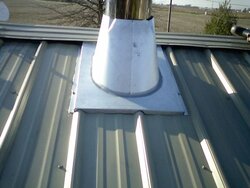I'm installing a class A chimney through a roof that has metal roof panels.
I think the easiest install of the flashing around the chimney is with a Silicone Rubber Roof Jack. The bottom of the roof jack has a piece of aluminum that is soft enough to form a perfect fit around the contours of the roof panel to get a good seal.
They have two types of rubber.
1. is EDPM rubber that is rated to 212 degrees F.
2. is Silicone rubber that is rated to 437 degrees F.
I'm guessing the EDPM is definitely not rated high enough for the class A, but the Silicone would be ok at 437 degrees?
would the EDPM work? there is a big difference in price!
thx
I think the easiest install of the flashing around the chimney is with a Silicone Rubber Roof Jack. The bottom of the roof jack has a piece of aluminum that is soft enough to form a perfect fit around the contours of the roof panel to get a good seal.
They have two types of rubber.
1. is EDPM rubber that is rated to 212 degrees F.
2. is Silicone rubber that is rated to 437 degrees F.
I'm guessing the EDPM is definitely not rated high enough for the class A, but the Silicone would be ok at 437 degrees?
would the EDPM work? there is a big difference in price!
thx


